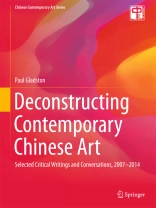The book presents a range of articles and discussions that offer critical insights into the development of contemporary Chinese art, both within China and internationally. It brings together selected writings, both published and unpublished, by Paul Gladston, one of the foremost international scholars on contemporary Chinese art. The articles are based on extensive first-hand research, much of which was carried out during an extended residence in China between 2005 and 2010. In contrast to many other writers on contemporary Chinese art, Gladston analyses his subject with specific reference to the concerns of critical theory. In his writings he consistently argues for a “polylogic” (multi-voiced) approach to research and analysis grounded in painstaking attention to local, regional and international conditions of artistic production, reception and display.
Table des matières
Preface.- Part 1 – Critical Essays.- Somewhere (and Nowhere) between Modernity and Tradition: Towards a Polylogue between Differing International and Indigenous Perspectives on the Significance of Contemporary Chinese Art.- International Curatorial Practice and The Problematic (De-)Territorialization of the International Survey Show: Critical Reflections on the Third Guangzhou Triennial, Farewell to Post-Colonialism.- Avant-Garde’ Art in Reform-era China: Divergence, Reversal and the Persistence of (Subjective) Realism.- Deconstructing Gao Minglu.- Cultural Translation and Post hoc Intellectual Conceit: Critical Reflections on the Conflating of Traditional Chinese Cultural Thought and Practice, and the Theory and Practice of Deconstruction in relation to the Theorizing of Contemporary Chinese Art.- Besiege Wei to Rescue Zhao: a Stratagem towards a Post-Crisical Art.- The (Continuing) Story of Ai: From Tragedy to Farce .- The Cult of Ai: a Critical Response to Ai Weiwei’s Comments on the Exhibition Art of Change: New Directions from China.- The Double Way: Contemporary Chinese Art and the Waning of Criticality.- Silence and Recuperation: the Pitiable sacrifice of the Artist Ai Weiwei .- Part 2 – Conversations.- Inside the Yellow Box: a Conversation with Johnson Chang.- Track Changes: a Conversation with Jia Jia.- Low Resolution: a Conversation with Zhang Peili.- Answering the Question: What is the Chinese Avant-Garde? – a Conversation with Zhai Zhenming.- Disjuncture – Tradition – Indirectness: a Conversation with Qiu Anxiong.- Collaboration as Struggle and Non-cooperation: A Conversation with Sun Yuan and Peng Yu.- Time, Life and Nature: A Conversation with Liang Shaoji.- A Conversation with He Sai Bang’ in Karen and Leon Wender (eds.).- Part 3 – Writing for Exhibitions.- Immersion: Song Ling’s Early Development as an Artist in the People’s Republic of China’ in Song Ling: a Retrospective .- Overlit Realm/Inner World: a Loosely Articulated Series of Notes on the Work of the Artist Lu Xinjian’ in Lu Xinjian City DNA IV.- Objectless Desire: a Loosely Articulated Series of Notes on Works by the Painter Tang Shu’ in Still Waters Run Deep: Tang Shu Works .- A Concise Series of Statements (that May or May not be) About the Work of the Artist Han Feng’ in Han Feng: Works .- The 14th Month (After the Great Flood): Towards an Alternative Reading of Yang Jiechang’s Stranger than Paradise’ in Yang Jiechang: Tale of the 11th Day .- Something (and Nothing) Beyond the Text: An Essay on the Work of Song Kun’ in Robin Peckham (ed.) Fragments: Xijia River Lethe – catalogue for an exhibition of work by the artist Song Kun.
A propos de l’auteur
Paul Gladston is a full professor at Nottingham – Chair of Contemporary Visual Cultures and Critical Theory. Between 2005 and 2010 he served as inaugural head of the Department of International Communications and director of the Institute for Comparative Cultural Studies at the University of Nottingham Ningbo, China. He has written extensively on the subject of contemporary Chinese art with particular reference to the concerns of critical theory. His recent book-length publications include Contemporary Art in Shanghai: Conversations with Seven Chinese Artists (Timezone 8 – Blue Kingfisher, 2011); a special edition of the Journal of Visual Art Practice, ‘Contemporary Chinese Art and Criticality’, co-edited with Katie Hill (2012); ‘Avant-Garde’ Art Groups in China, 1979–89 (Intellect and University of Chicago Press, 2013); and Contemporary Chinese Art: A Critical History (Reaktion and University of Chicago Press, 2014). He is principal editor of the Journal of Contemporary Chinese Art and was an academic adviser to the exhibition ‘Art of Change: New Directions from China’, which was staged at the South Bank Centre in London in 2012.




